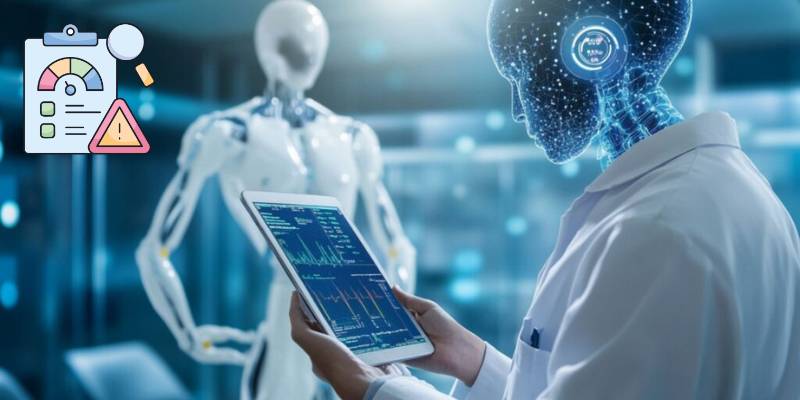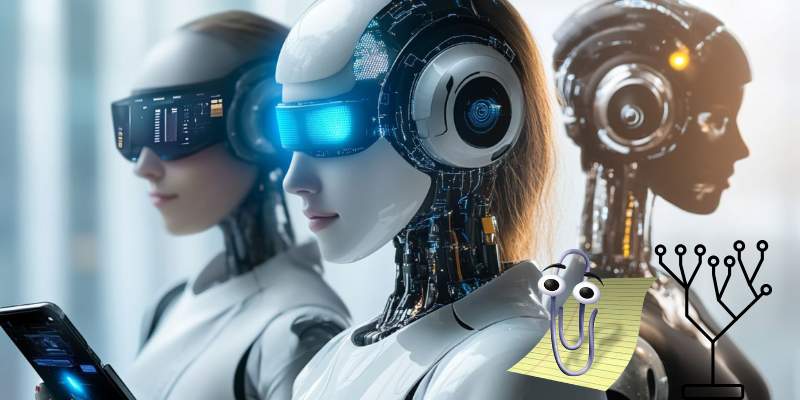Not too long ago, the idea of talking to a machine about our health would’ve sounded ridiculous. “You mean I’d tell a computer I’ve got a fever?”—the image itself feels absurd. And yet, here we are.
AI assistants are already whispering their way into clinics, hospitals, pharmacies, and even our bedrooms through wearable devices.
The bigger question isn’t whether this is happening—it already is. The real dilemma is whether this slow and steady infiltration of AI into healthcare is a blessing or a risk.
And if you ask me, it’s a bit of both, which is exactly why the topic deserves a long, careful look.
Why Healthcare Needs Help
Before we get carried away, let’s acknowledge something blunt: the U.S. healthcare system is struggling. Costs are skyrocketing. Doctors are exhausted.
Patients wait weeks, sometimes months, for appointments. According to the Association of American Medical Colleges, the U.S. could face a shortage of up to 124,000 physicians by 2034 (AAMC report).
In that light, an AI assistant that helps triage symptoms, schedule appointments, or monitor chronic conditions doesn’t sound like a luxury—it sounds like a lifeline.
Where AI Assistants Are Already Making Waves
AI in healthcare isn’t just some futuristic dream. It’s here, in multiple forms:
- Virtual health assistants that answer patient questions and guide them through treatment options.
- Remote monitoring tools that track blood pressure, glucose, or heart rate, then flag anomalies.
- Medication reminders built into smart speakers for elderly patients.
- AI-driven chatbots used in telehealth apps to filter urgent cases from routine ones.
And the adoption isn’t slowing down. A report from Accenture estimated that AI applications in healthcare could save the U.S. economy $150 billion annually by 2026 (Accenture study).
Sounds like a blessing, right? Well, not so fast.
The Blessings: Why People Are Excited
Accessibility
Imagine being in a rural town with no specialists nearby. An AI assistant can bridge that gap, guiding you toward accurate information or helping connect you to virtual consultations. It doesn’t replace doctors, but it buys you time and clarity.
Efficiency
Doctors spend a shocking portion of their time on paperwork. AI assistants can transcribe medical notes, file records, and reduce clerical errors. That means more time with patients, which is what doctors actually signed up for.
Personalized Care
AI assistants can analyze patterns in health data that humans might miss. For example, a subtle rise in heart rate combined with irregular sleep patterns might prompt early intervention for cardiac issues. It’s not just treatment—it’s prevention.
Support for Caregivers
Here’s where empathy kicks in. Think about the parent juggling two jobs and still trying to keep up with a diabetic child’s health needs.
Or the adult child taking care of an aging parent with dementia. AI assistants can serve as round-the-clock helpers, offering reminders, alerts, and guidance that lighten the load.
These are real blessings—tangible improvements that save time, reduce stress, and maybe even save lives.
The Risks: The Other Side of the Coin
But let’s turn the coin. Because, as much as I want to be optimistic, there are some heavy risks.
Privacy and Data Security
Your health data isn’t just data—it’s the most intimate map of your life. Where is it stored? Who has access? And what happens if it gets hacked?
A 2023 report by IBM found that healthcare data breaches cost an average of $10.93 million per incident, the highest across all industries (IBM Cost of Data Breach Report).
Now, add AI assistants to the mix. They collect voice samples, emotional cues, and real-time health stats. It’s a goldmine for hackers—or corporations looking to monetize insights.
Accuracy Issues
AI isn’t perfect. A misinterpretation of symptoms could send someone into panic—or worse, delay necessary care.
While studies show AI diagnostic tools can match or even outperform doctors in certain tasks, errors still happen.
And when they do, who’s accountable—the developer, the hospital, or the patient who trusted the machine?
Emotional Dependence
There’s another subtle risk: emotional reliance. Some patients, especially the elderly or socially isolated, may lean on AI assistants for comfort.
While companionship isn’t inherently bad, confusing a programmed response with genuine empathy might deepen loneliness in the long run.
And here’s where the uneasy phrase comes in: the truth about The Dark Side of AI Assistants. It’s not just about glitches or bugs.
It’s about creating relationships that look like care but are really just algorithms feeding us what we want to hear.
A Story From the Real World
I’ll share a story that stuck with me.
A colleague’s grandmother, living alone, used a smart assistant to manage her medications. Over time, she began to talk to it as if it were a companion—asking it how its “day” was. Harmless?
Maybe. But when the assistant failed to remind her one night because of a Wi-Fi outage, she missed a crucial pill. It wasn’t catastrophic, but it highlighted the fragile balance between help and dependence.
Technology can empower us, but it can also let us down at the worst possible moment.
Special Considerations: Key Insights from AI Assistants for the Elderly
The elderly are a focal point in this conversation. They often benefit most from reminders, monitoring, and companionship. AI assistants can ease the burden of memory lapses or provide quick access to medical information.
But here’s what we need to consider:
- Ease of use – Interfaces must be intuitive. Complicated menus or rigid commands won’t work for someone in their eighties.
- Cultural sensitivity – Not every elderly patient grew up trusting machines. For some, even speaking to an AI feels alien.
- Safety nets – There must always be a human backup plan. Elderly patients can’t be left stranded when technology inevitably fails.
The promise here is huge, but so is the responsibility.
The Global Dimension: Questions Around Multilingual AI Assistants
Healthcare isn’t one-size-fits-all. In the U.S. alone, millions of patients prefer communicating in Spanish, Mandarin, or other languages. The idea of questions around Multilingual AI Assistants becomes crucial here.
If an assistant misunderstands a phrase in another language, the error isn’t just awkward—it could be dangerous.
And beyond translation, there’s the cultural layer. In some cultures, patients avoid direct “yes/no” answers about pain out of politeness. Will AI assistants understand that nuance?
I’m skeptical. At least for now, cultural missteps are a real risk.
Regulation and Responsibility: Breaking Down Should Governments Regulate AI Assistants Like Public Utilities?
This is where the conversation turns political. Should governments step in? Should AI assistants, especially in healthcare, be regulated the way we regulate electricity or water?
On one hand, regulation feels necessary. Healthcare touches life and death, and the consequences of unchecked AI are too severe to leave to corporate interests.
On the other hand, too much red tape could stall innovation at a time when healthcare desperately needs new tools.
My personal take? Yes, regulation is essential, but it has to be smart regulation—focused on transparency, accountability, and equity. AI shouldn’t be a luxury only available to the wealthy. It should be a public good, but one we manage carefully.
Emotional AI: The Grey Zone
One of the strangest, most delicate areas of this whole debate is emotional AI. Should assistants recognize when you’re anxious and respond gently? Should they detect sadness in your voice and offer calming words?
Part of me wants that. After all, who doesn’t like being heard? But the other part of me resists. Machines can’t really care.
And pretending they do risks blurring the line between authentic human empathy and programmed mimicry.
This matters in healthcare more than anywhere else. Because when you’re sick, scared, or vulnerable, the last thing you need is a machine giving you “care” it can’t actually feel.
Looking Ahead: What the Future Could Look Like
So, what’s next? A few possibilities:
- Hybrid care – AI assistants handling routine tasks while doctors focus on complex, human-centered care.
- Preventive healthcare – AI detecting problems early and nudging patients toward healthier habits.
- Global reach – Multilingual AI breaking barriers for underserved populations.
- More risks – Data misuse, emotional manipulation, and overreliance.
The truth is, the future will probably be a messy blend of blessing and risk. The best-case scenario is one where AI amplifies human care without replacing it.
The worst-case scenario? A system that prioritizes efficiency over empathy, leaving patients feeling like data points rather than people.
Final Reflection: My Personal Stance
So, is AI in healthcare a blessing or a risk? Honestly, it’s both, and it depends on how we shape it.
I believe AI assistants can and should play a role in making healthcare more accessible, affordable, and responsive. But they must never replace the irreplaceable: the human connection between caregiver and patient.
Machines don’t get tired, but they also don’t care. And in medicine, sometimes caring is the treatment itself.
That’s where I land. Use AI to assist, not to pretend. Use it to empower, not to manipulate. And above all, never forget that healthcare is about people, not just problems to be solved.
Closing Thought
The arrival of AI assistants in healthcare is neither an unqualified blessing nor an inevitable disaster. It’s a crossroads moment.
And the choices we make now—about regulation, design, accessibility, and ethics—will determine whether we look back in twenty years and say, “This saved lives,” or, “We lost something essential in the process.”
It’s a blessing and a risk. And the balance between the two is in our hands.


